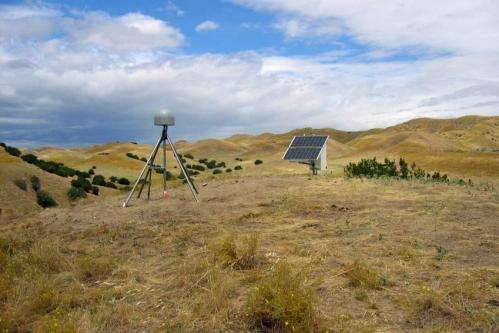Severe drought is causing the western US to rise

The severe drought gripping the western United States in recent years is changing the landscape well beyond localized effects of water restrictions and browning lawns. Scientists at Scripps Institution of Oceanography at UC San Diego have now discovered that the growing, broad-scale loss of water is causing the entire western U.S. to rise up like an uncoiled spring.
Investigating ground positioning data from GPS stations throughout the west, Scripps researchers Adrian Borsa, Duncan Agnew, and Dan Cayan found that the water shortage is causing an "uplift" effect up to 15 millimeters (more than half an inch) in California's mountains and on average four millimeters (0.15 of an inch) across the west. From the GPS data, they estimate the water deficit at nearly 240 gigatons (62 trillion gallons of water), equivalent to a six-inch layer of water spread out over the entire western U.S.
Results of the study, which was supported by the U.S. Geological Survey (USGS), appear in the August 21 online edition of the journal Science.
While poring through various sets of data of ground positions from highly precise GPS stations within the National Science Foundation's Plate Boundary Observatory and other networks, Borsa, a Scripps assistant research geophysicist, kept noticing the same pattern over the 2003-2014 period: All of the stations moved upwards in the most recent years, coinciding with the timing of the current drought.
Agnew, a Scripps Oceanography geophysics professor who specializes in studying earthquakes and their impact on shaping the earth's crust, says the GPS data can only be explained by rapid uplift of the tectonic plate upon which the western U.S. rests (Agnew cautions that the uplift has virtually no effect on the San Andreas fault and therefore does not increase the risk of earthquakes).
For Cayan, a research meteorologist with Scripps and USGS, the results paint a new picture of the dire hydrological state of the west.
"These results quantify the amount of water mass lost in the past few years," said Cayan. "It also represents a powerful new way to track water resources over a very large landscape. We can home in on the Sierra Nevada mountains and critical California snowpack. These results demonstrate that this technique can be used to study changes in fresh water stocks in other regions around the world, if they have a network of GPS sensors."
More information: "Ongoing drought-induced uplift in the western United States," by A.A. Borsa et al. Science, www.sciencemag.org/lookup/doi/ … 1126/science.1257750
Journal information: Science
Provided by University of California - San Diego




















